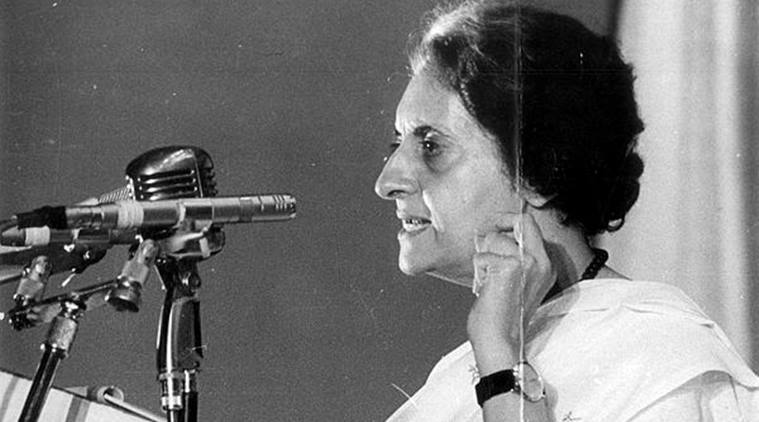Telescope: Can history be far behind?
In New India, on screen and off it, the past overtakes the present

Former Prime Minister Indira Gandhi. (Express archive photo)
In 2014, Narendra Modi promised Indians “achche din” ahead. In 2018, this Tuesday, the prime minister promised the Asian Infrastructure Investment Bank and those of us watching his speech on TV, that “a New India is rising”. Very forward of him, you might say, because he has an eye on the future.
So, it is all the more curious that the PM and all the prime minister’s men keep harping on the past. And television rewinds along with them: While TV news dwells on the past mistakes of the Congress Party ever since Jawaharlal Nehru was PM, entertainment TV has returned to mythological times before taking on Alexander and the British.
Monday was the “43rd anniversary of the Emergency” (Mirror Now); the BJP and many TV news channels observed a “Black Day” that stretched beyond 24 hours into Tuesday evening. On both days, footage of former prime minister Indira “Hitler” Gandhi (inspired by Finance Minister Arun Jaitley’s blog post) and those terrible 21 months, blackened the screen, courtesy the black and white video.
Outraged anchors demanded that Rahul Gandhi “apologise” for everything since the Emergency — and up to last week’s comments by Congressman Ghulam Nabi Azad on Kashmir. “Isn’t it true that films were censored during that period?” The Republic anchor thundered on Tuesday, inadvertently, and immediately, reminding us of the protests and calls for censoring Padmaavat before the Supreme Court had to order states to allow the film’s release, earlier this year.
Living in the past can be double-edged as the BJP and TV channels, horrified by the excesses of the Emergency, found out: Raking up the Emergency, allowed the Congress and others to attack the ruling party. Politician-academic Yogendra Yadav, for instance, compared abuses of power between June 1975 and February 1977 with current developments and found the two almost identical (NDTV 24×7).
Sometimes, we should let bygones begone and concentrate on the present.
(By the way, June 25 is also the day in 1983 when India won its first cricket World Cup with “Kapil’s Devils” but no news channel was interested in that piece of the past.)
Since the history of this nation has been pretty venal since Independence according to this political reading of it, we need to go back in time— way, way back — to find solace in myth and magic. Join Ganesh, flying serenely on the strength of his redoubtable trunk (Vighnaharta Ganesh, Sony), along with the stellar pantheon of Vishnu, Brahma, Shiva, and an assortment of devas and asuras. This is your typical mythological, one of the many on air since the BJP victory in 2014 and the resurgence of interest in matters Hindu.
Myth gives easily away to the supernatural with us and you need look no further than Naagin 3 (Colors) which is topping the TV viewership charts for the third time. Highly decorous and decorated nubile young woman-naagins have cast a sensuous spell over viewers, in this super series where anyone and anything can snake up and take you by surprise. Here past and present superstitions merge for a weird love story.
Can history be far behind? Especially, after the renewed interest in nationalism and, its identification with martial pride. The armed forces have been thrust centrestage in the last few years, particularly on TV — think Pakistan’s incursions into Indian territory like Pathankot (History TV18 channel is running a Special Operations India series on that incident) , “surgical strikes,” the unrest in Kashmir and the Doklam stand-off with China. Also, note the number of former army officers in TV studio debates. One show says it all: Patriot, devoted to the armed forces, on Republic, identifies national honour with military valour.
And so, hark back again to instances when Indian soldiers, men of arms did us proud: 21 Sarfarosh-Saragarhi 1897 (Jeet Discovery) depicts the bravery of a handful of Indian faujis holding off thousands of marauding Afghan invaders; Shere Punjab Maharaja Ranjit Singh (Life OK) was on the life of the great Sikh warrior-king, there’s Porus (Sony), circa 350 BC, and his encounters against Darius and Alexander to save our land, and most recently, Chandrashekhar (Star Bharat), the biopic of the freedom fighter Chandrashekhar Azad.
Standout features of all of these? By and large, there is far greater realism in the sumptuous productions. And notably, the “foreign hands” are not Indians trying to speak the Queen’s English with a British accent.
Above all, however, is the resplendent, larger-than-life portrayal of the lead characters: They are no longer the feeble, half-naked fakirs in loin cloths who wield a danda: They are tall, well-built, strong heroes, fit for the sets of a Hollywood film like Gladiator or Ben Hur. Truly, the empire strikes with these daring and inspiring figures.
Are these the perfect role models in the “rediscovery” of India for a young, “rising” “New India”? Maybe something to think about.
shailaja.bajpai@expressindia.com
For all the latest Opinion News, download Indian Express App
More From Shailaja Bajpai
- Telescope: To 2019, with machismoOn the football field and on Kashmir, there’s a lot of testosterone around..
- Telescope: Upside downCongress president sounds like PM. And news shows question ruling party..
- Telescope: After IPLAway from cricket, we have other concerns. Or do we?..








































No hay comentarios:
Publicar un comentario